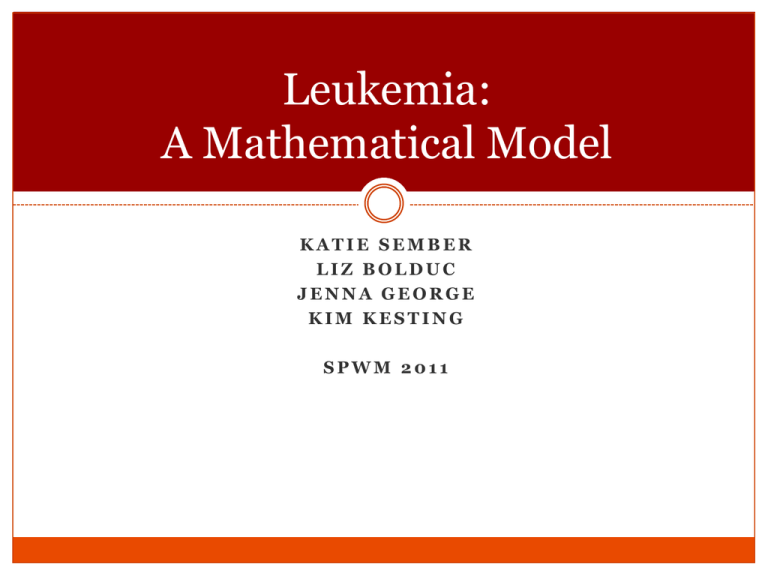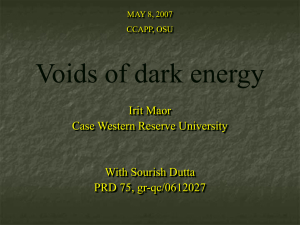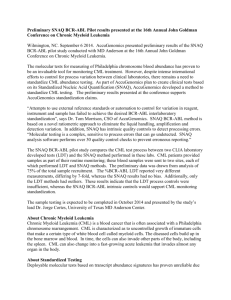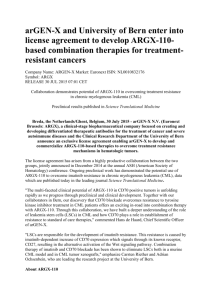Leukemia: A Mathematical Model
advertisement

Leukemia: A Mathematical Model KATIE SEMBER LIZ BOLDUC JENNA GEORGE KIM KESTING SPWM 2011 Liz Bolduc Holy Cross ’12 Zodiac Sign: Leo Favorite Math Class: Principles of Analysis Favorite Math Joke: What’s the integral of 1/cabin? Log(cabin) No, a boat house! You forgot to add the C! Katie Sember Buffalo State College ’12 Zodiac Sign: Gemini Favorite Math Class: Abstract Algebra Favorite Math Joke: What’s purple and commutative? An abelian grape! Jenna George William Paterson University ‘12 Zodiac Sign: Sagittarius Favortie Math Class: Group Theory Favorite Math Joke: The number you have dialed is imaginary, please rotate your phone by 90o and try again. Kim Kesting Fairfield University ‘12 Zodiac Sign: Pisces Favortie Math Class: Real Anaylsis Favorite Math Joke: A mathematician is asked by a friend who is a devout Christian, “do you believe in one God?” He answers, “Yes, up to isomorphism.” Chronic Myelogenous Leukemia (CML) •Bone marrow makes blood stem cells that develop into either myeloid or lymphoid stem cells. •Lymphoid stem cells develop into white blood cells. •Myeloid Stem cells develop into 3 types of blood cells: •Red Blood Cells- carry oxygen and other materials to tissues •Platelets- help prevent bleeding by causing blood clots •Granulocytes (WBC)- fight infection and disease Chronic Myelogenous Leukemia (CML) • In CML, too many stem cells turn into granulocytes that are abnormal and do not become healthy white blood cells. • Referred to as Leukemia cells • These Leukemia cells build up in blood and bone marrow leaving less room for healthy cells and platelets. • This leads to infection, anemia, and easy bleeding. Periodic Chronic Myelogenous Leukemia (CML) • Typically, the production of blood cells is relatively constant. • In diseases such as CML, the growth of white blood cells is uncontrolled and can sometimes occur in an oscillatory manner. Goal of Modeling • To discover the site of action of the feedback that controls blood cells growth and that can lead to growth in oscillatory manner. We can do this by using a Delay Differential Equation!! Why a DDE? • We want to study the change in the total number of cells in the blood stream • New cells are always being produced and/or dying – these are the changes we want to take into account. • However, cell production in the bone marrow takes time. The number of cells secreted at a certain time is in relation to the number of cells in the blood stream some time t – d ago. This is our delay! Our Basic DDE Model Change in total number of cells at time t Density of cells at their maximum age dN n(0,t) n(X,t) n dt Density of brand new cells Cells that die before maximum age Adding a New Function into the Mix Consider a new function, F, that is a production function related to the rate of secretion of growth inducer in response to the blood cell population size. n(0,t) F(N(t d)) From this equation, we see that the total number of new cells in the bloodstream is a result of the total number of cells that were in the bloodstream t – d days ago. Our New DDE Model In this case, F is the number of new cells produced in relation to the number of cells present at time t – d – X days ago. dN F(N(t d)) F(N(t d X))e X N dt Cell survival probability F is a function that produces new cells based on the total number of cells that were present in the blood stream t – d days ago. Our DDE Model The number of cells that reach the maximum age and die dN F(N(t d)) F(N(t d X))e X N dt Brand new cells that have just left the bone marrow and entered the bloodstream The number of cells that die before reaching maximum age. 𝐹(𝑁) Population of Blood Cells 𝐹(𝑁 𝑡 − 𝑑 − 𝑋 )𝑒 −𝛽𝑡 𝐹(𝑁 𝑡 − 𝑑 ) 𝑁 𝛽𝑛 𝑑𝑁 =𝐹 𝑁 𝑡−𝑑 𝑑𝑡 −𝐹(𝑁 𝑡 − 𝑑 − 𝑋 )𝑒 −𝛽𝑡 −𝛽𝑛 Linearization of our DDE • In order to determine stability of our delay differential equation, we first linearize the equation around the steady state solution N0. • We are looking for solutions of the form: N(t)=N0 + N0εeλt y(t) = x – x* or x* + y(t) =x where y(t) = Keλt Linearization of our DDE • Now we substitute N(t) into our DDE and take the derivative with respect to N. F'(N 0 )ed F'(N 0 )e(d X )eX • For our purposes, we want to consider the case where β = 0. This implies that all cells die exactly at age X. • As the lim β 0, the characteristic equation becomes: F'(N 0 )(e d e (d X ) ) Determining Stability from Roots • The roots of this characteristic equation determine the stability of the linearized solution. F'(N 0 )(e d e (d X ) λ Stability Negative real part Stable Positive real part* Unstable ) * The only way to have a positive real part is if the solution is a complex number, because F ’(N0)<0. Determining Stability from Roots • If the steady state solution is stable, the return to steady state is oscillatory rather than monotone. • Following rapid distributions of blood cell population, such as traumatic blood loss, or transfusion, or a vacation at a high altitude ski resort, the blood cell population will oscillate about its steady state. Changes in Stability • The only way to have a root with a positive real part is if the root is complex • Transitioning from stable to unstable can occur only if the complex root changes the sign of its real part. • Hopf bifurcation, where λ=iω. Possible Changes in Stability We notice a change in stability due to a relationship between and. X dF(0) d The implications of this relationship are interesting: • If our parameters lie above the curve then the solution is unstable • If the parameters lie below, our solution is stable What does this mean biologically? Three mechanisms determine the stability of cell production: • The time it takes for new cells to enter the bloodstream • The expected life expectancy • The rate at which new cells are produced Changing the Parameters Recall: • The usually instability occurs when X is lower than normal d •Thus d must increase or X must decrease Change in the Delay Change in Variable A in Function F(N) Change in p value in the function F(N) THANKS FOR A GREAT CLASS ANGELA!! I Crocodilia!!











